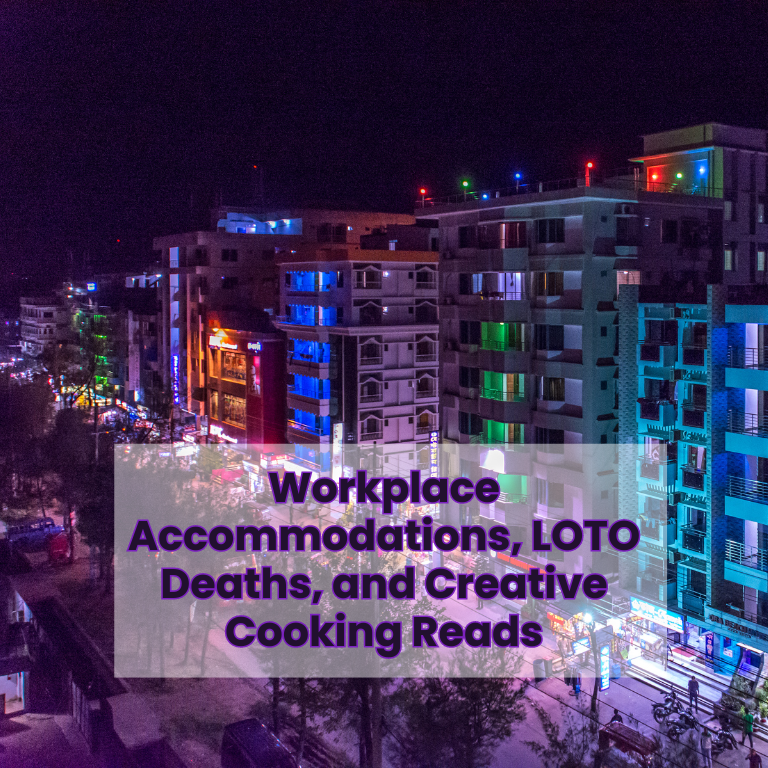What I’m Reading: LOTO Deaths, Workplace Help, Creative Cooking

In today’s dynamic workplace and evolving industries, safety and inclusivity have become paramount. From accommodating diverse employee needs to addressing preventable workplace fatalities, businesses must navigate a complex set of challenges to foster a healthy, productive environment. This article explores three critical and distinct areas: workplace accommodations, the dangers of Lockout/Tagout (LOTO) failures, and the rise of creative cooking literature, all of which impact how we work, live, and create.
Workplace Accommodations: Fostering Inclusion and Productivity
Workplace accommodations are integral to ensuring that employees with disabilities, health conditions, or other unique needs can perform their jobs effectively. These accommodations, required under laws like the Americans with Disabilities Act (ADA), enable organizations to promote inclusivity, boost morale, and maintain compliance with regulations.
What Are Workplace Accommodations?
Workplace accommodations refer to any modifications or adjustments made to a job or work environment that allow an employee to perform essential duties. These changes can vary widely depending on the employee’s needs, the type of job, and the industry in question. Common accommodations include:
Modified Work Schedules: Allowing flexible hours for employees with medical conditions or family obligations.
Assistive Technology: Providing software, equipment, or tools that assist in communication or task performance for employees with disabilities.
Ergonomic Adjustments: Changing the layout of workspaces or providing ergonomic chairs and desks to reduce physical strain.
Remote Work Options: Especially in light of the COVID-19 pandemic, many employers have extended the option for employees to work from home to accommodate health concerns or mobility issues.
The Legal Framework for Accommodations
Under the ADA, employers are legally required to provide reasonable accommodations unless doing so would cause undue hardship on the business. Reasonable accommodations are those that do not impose significant difficulty or expense on the employer. The law applies to businesses with 15 or more employees and covers a wide range of disabilities, including physical, mental, and emotional conditions.
The process of providing accommodations generally starts with an employee requesting a modification and then working with the employer to find a suitable solution. Employers should take a proactive approach, fostering an open environment where employees feel comfortable discussing their needs. Ensuring inclusivity is not just about meeting legal requirements but also about enhancing the overall work environment and retaining top talent.
LOTO Deaths: The Dangers of Failing to Lockout/Tagout
The manufacturing, construction, and industrial sectors are particularly susceptible to safety risks, with Lockout/Tagout (LOTO) procedures serving as one of the most critical elements in preventing workplace accidents. LOTO procedures involve isolating hazardous energy sources during equipment servicing or maintenance to protect workers from potential harm. Despite strict regulations from the Occupational Safety and Health Administration (OSHA), LOTO failures continue to result in serious injuries and deaths.
What Is Lockout/Tagout (LOTO)?
LOTO is a safety procedure used to ensure that dangerous machines are properly shut off and unable to be restarted during maintenance or repair work. This involves physically locking the machinery’s energy sources (such as electricity, hydraulics, or gas) and placing a tag on the lock to indicate that the equipment is undergoing maintenance. The tag serves as a visual warning that the equipment cannot be operated until the lock is removed by the authorized personnel.
The Cost of LOTO Failures
Despite the clarity of LOTO procedures, there are numerous examples of workplaces failing to implement these safety measures, often with tragic results. According to OSHA, failure to comply with LOTO standards is one of the top 10 most frequently cited violations, and these lapses can lead to serious injury or death.
Inadequate Training: Many LOTO-related accidents occur because workers are not adequately trained in the procedure or do not understand the risks involved. Training is essential to ensure that employees are aware of the hazards of working with energized equipment and understand the proper LOTO procedures.
Failure to Use Lockout Devices: In some cases, employers fail to provide the necessary lockout devices, or workers bypass them in the interest of saving time. This can lead to catastrophic accidents, as machinery unexpectedly starts up while being serviced.
Neglecting LOTO in Multi-Employer Worksites: On construction sites or in factories where multiple contractors or employees from different companies are working, communication is vital. A failure to coordinate LOTO procedures across teams can result in dangerous situations where one worker assumes the equipment is de-energized while another inadvertently reactivates it.
Preventing LOTO-Related Deaths
The key to preventing LOTO accidents is a combination of rigorous training, consistent enforcement of safety procedures, and fostering a culture of safety where shortcuts are not tolerated. Employers must ensure that every worker understands their role in LOTO and that supervisors regularly inspect equipment and procedures for compliance. Using modern technology, such as digital tracking systems, can further ensure that LOTO protocols are followed without fail.
Creative Cooking Reads: A New Frontier in Culinary Exploration
While workplace accommodations and safety procedures deal with pragmatic, high-stakes topics, there is also a creative and imaginative side to how people experience life, notably in the world of food. In recent years, the world of culinary arts has expanded beyond traditional cookbooks, giving rise to “creative cooking reads”—literature that blends storytelling, science, and gastronomy in ways that are as entertaining as they are educational.
What Are Creative Cooking Reads?
Creative cooking reads go beyond simple recipe books. These works explore the science, history, and art behind cooking, often offering a narrative element that engages readers. They are not just instructional but inspire a deeper appreciation for the culinary world. Popular examples include:
“Salt, Fat, Acid, Heat” by Samin Nosrat: This book explains the four fundamental elements of cooking—salt, fat, acid, and heat—offering insights into how mastering these components can elevate any dish. Nosrat’s engaging writing style makes it both an instructional guide and an entertaining read.
“The Flavor Bible” by Karen Page and Andrew Dornenburg: Instead of offering recipes, this book provides a comprehensive guide to flavor pairings, encouraging cooks to be creative and experiment in the kitchen.
“Cooking for Geeks” by Jeff Potter: This book blends science and cooking, teaching readers how to use the principles of physics and chemistry to improve their culinary techniques.
Why Creative Cooking Reads Matter
These books are changing the way people approach food. Instead of strictly following recipes, readers are encouraged to think critically about the ingredients and techniques they use. This shift has had several positive impacts:
Empowerment in the Kitchen: By focusing on the “why” behind cooking methods, these books give home cooks the confidence to experiment and innovate, rather than relying on strict instructions.
Sustainability and Local Sourcing: Many creative cooking reads emphasize the importance of understanding where ingredients come from and how to use them sustainably. This awareness is fostering a new generation of cooks who prioritize ethical food practices.
Food as an Art Form: These books elevate cooking from a mere necessity to an art form, encouraging readers to see the process of preparing food as a creative outlet.
The Intersection of Safety, Accommodation, and Creativity
Workplace accommodations, safety procedures like LOTO, and creative outlets like cooking may seem unrelated at first glance, but they all share a common thread—each addresses the human need for balance, protection, and expression. Whether it’s making the workplace more inclusive and safe or allowing for creative exploration in the kitchen, these topics illustrate the evolving nature of how we work, live, and create.
By prioritizing accommodations for employees, ensuring strict adherence to safety standards, and embracing creative pursuits, individuals and organizations alike can cultivate environments that are both productive and enriching.











